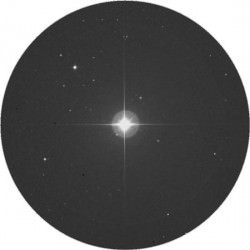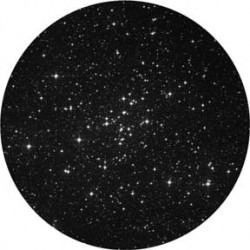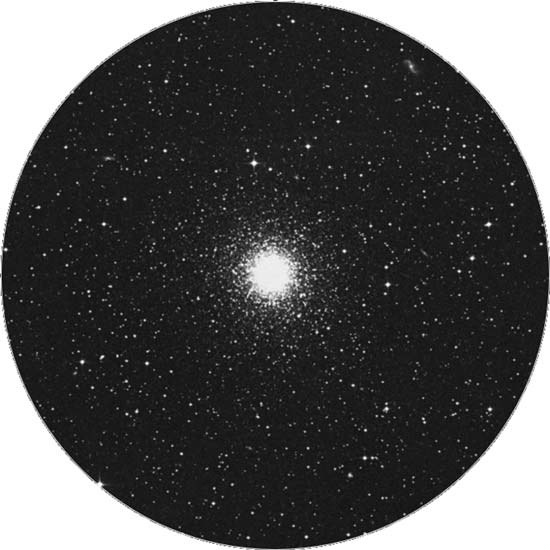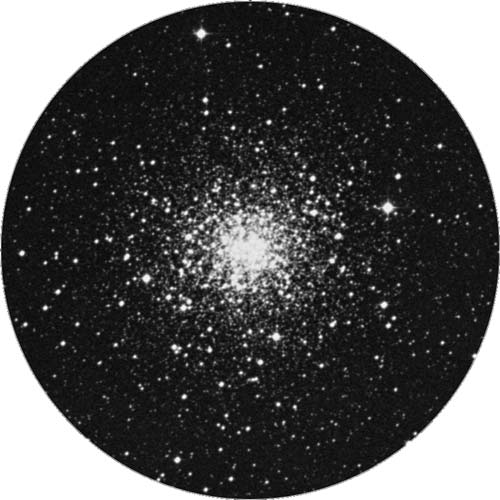Greetings, fellow SkyWatchers! It’s a picturesque weekend to get up early as the Moon heads for the Pleiades and on towards a close encounter with Venus. With plenty of dark skies to go around and the random meteor rate a little higher than usual, why not spend some time with the constellation of Lupus? No telescope or binoculars? No problem. There’s also plenty of things to do over the next few days that only requires just your eyes and a little knowledge of the skies. I’ll see you in the backyard…
 Friday, July 17, 2009 – This date marks the 1904 passing of Isaac Roberts, an English astronomer who specialized in photographing nebulae. Since many deep sky objects are far too faint to be seen with the human eye, photography soon became a great way of studying them, but as the Earth moved, long exposure photography became problematic as the image also moved and blurred. Roberts’ developed a telescope/camera combination which would track, allowing for a long exposure times and perfected images. As an ironic twist, this is also the date on which a star was first photographed at Harvard Observatory!
Friday, July 17, 2009 – This date marks the 1904 passing of Isaac Roberts, an English astronomer who specialized in photographing nebulae. Since many deep sky objects are far too faint to be seen with the human eye, photography soon became a great way of studying them, but as the Earth moved, long exposure photography became problematic as the image also moved and blurred. Roberts’ developed a telescope/camera combination which would track, allowing for a long exposure times and perfected images. As an ironic twist, this is also the date on which a star was first photographed at Harvard Observatory!
Tonight let’s have a look at a real little power punch globular cluster located in northern Lupus— NGC 5824. Although it’s not an easy star hop, you’ll find it about 7 degrees southwest of Theta Librae,
and exactly the same distance south of Sigma Librae (RA 15 03 58 Dec –33 04 04). Look for a 5th magnitude star in the finderscope to guide you to its position southeast.
As a Class I globular cluster, you won’t find any others that are more concentrated than this. Holding a rough magnitude of 9, this little beauty has a deeply concentrated core region that is simply unresolvable. Discovered by E.E. Barnard in 1884, it enjoys its life in the outer fringes of its galactic halo about 104 light-years away from Earth and contains many recently discovered variable stars. Oddly enough, this metal-poor globular may have been formed by a merger. Research on GC 5824’s stellar population leads us to believe that two less dense and differently aged globulars may have approached one another at a low velocity and combined to form this ultra-compact structure. Be sure to mark your observing notes on this one! It also belongs to the Bennett catalog and is part of many globular cluster lists.
Saturday, July 18, 2009 – Celestial scenery alert! Get up before dawn to witness the Moon graze by the Pleiades. For some observers, the pair will be separated by around half a degree; it will be an occultation event for others. Still not enough? Then be sure to look for the twin red pair of Mars and Aldebaran spaced equidistant to the Moon’s south!
 Tonight let’s begin with the 1689 birth of Samuel Molyneux. This British astronomer and his assistant were the first to measure the aberration of starlight. What star did they choose? Alpha Draconis, which oscillated with an excursion of 39’’ from its lowest declination in May. Why choose a single star during an early dark evening? Because Alpha Draconis—Thuban—is far from bright. At magnitude 3.65, Thuban’s ‘‘alpha’’ designation must have come from a time when it, not Polaris, was the northern celestial pole star. If you’re aware that the two outer stars of the ‘‘dipper’’ point to Polaris, then use the two inner stars to point to Thuban (RA 14 04 23 Dec +64 22 33). This 300-light-year distant white giant star is no longer main sequence, a rare binary type.
Tonight let’s begin with the 1689 birth of Samuel Molyneux. This British astronomer and his assistant were the first to measure the aberration of starlight. What star did they choose? Alpha Draconis, which oscillated with an excursion of 39’’ from its lowest declination in May. Why choose a single star during an early dark evening? Because Alpha Draconis—Thuban—is far from bright. At magnitude 3.65, Thuban’s ‘‘alpha’’ designation must have come from a time when it, not Polaris, was the northern celestial pole star. If you’re aware that the two outer stars of the ‘‘dipper’’ point to Polaris, then use the two inner stars to point to Thuban (RA 14 04 23 Dec +64 22 33). This 300-light-year distant white giant star is no longer main sequence, a rare binary type.
 Now head to binary Eta Lupi, a fine double star resolvable with binoculars. You’ll find it by staring at Antares and heading due south two binocular fields to center on bright H and N Scorpii—then one binocular field southwest. Now hop 5 degrees southeast (RA 16 25 18 Dec – 40 39 00) to encounter the fine open cluster NGC 6124. Discovered by Lacaille, and known as object I.8, this 5th magnitude open cluster is also Dunlop 514, Melotte 145, and Collinder 301. Situated about 19 light years away, it shows a fine, round, faint spray of stars to binoculars and is resolved into about 100 stellar members to larger telescopes. Although NGC 6124 is low for northern observers, it’s worth the wait to try at culmination. Be sure to mark your notes because this delightful galactic cluster is also a Caldwell object and counts for a southern skies binocular award.
Now head to binary Eta Lupi, a fine double star resolvable with binoculars. You’ll find it by staring at Antares and heading due south two binocular fields to center on bright H and N Scorpii—then one binocular field southwest. Now hop 5 degrees southeast (RA 16 25 18 Dec – 40 39 00) to encounter the fine open cluster NGC 6124. Discovered by Lacaille, and known as object I.8, this 5th magnitude open cluster is also Dunlop 514, Melotte 145, and Collinder 301. Situated about 19 light years away, it shows a fine, round, faint spray of stars to binoculars and is resolved into about 100 stellar members to larger telescopes. Although NGC 6124 is low for northern observers, it’s worth the wait to try at culmination. Be sure to mark your notes because this delightful galactic cluster is also a Caldwell object and counts for a southern skies binocular award.
 Sunday, July 19, 2009 – Want a picturesque sight before dawn? Then look for the close pairing of Venus and the Moon. Which has the greater crescent? This probably would have interested Edward Charles Pickering, who was born on this date in 1864. Pickering was the director of Harvard College Observatory for 42 years and published the first all-sky photographic map in 1902. While at Harvard, he recruited many women to work for him, including Annie Jump Cannon, Henrietta Swan Leavitt, and Antonia Maury. These women were called “Pickering’s Harem” by the scientific community – but don’t you believe any crap for one instant. In those days, it was incredibly difficult for a woman to have her academic work recognized and Edward Pickering was one of the very few men open-minded enough to realize just what these women astronomers could achieve and allow them the chance to do it!
Sunday, July 19, 2009 – Want a picturesque sight before dawn? Then look for the close pairing of Venus and the Moon. Which has the greater crescent? This probably would have interested Edward Charles Pickering, who was born on this date in 1864. Pickering was the director of Harvard College Observatory for 42 years and published the first all-sky photographic map in 1902. While at Harvard, he recruited many women to work for him, including Annie Jump Cannon, Henrietta Swan Leavitt, and Antonia Maury. These women were called “Pickering’s Harem” by the scientific community – but don’t you believe any crap for one instant. In those days, it was incredibly difficult for a woman to have her academic work recognized and Edward Pickering was one of the very few men open-minded enough to realize just what these women astronomers could achieve and allow them the chance to do it!
Tonight for unaided observers, let’s begin by identifying Zeta Ophiuchi, the centermost in a line of stars marking the edge of the constellation of Ophiuchus, about a handspan north of Antares. As a magnificent 3rd magnitude blue-white Class O, this hydrogen-fusing dwarf is eight times larger than our own Sun. Hanging out some 460 light-years away, it is dulled by the interstellar dust of the Milky Way and would shine two full magnitudes brighter if it were not obscured. Zeta is a ‘‘runaway star’’—a product of a one-time supernova event of a double-star system. Now roughly halfway through its 8 million-year life span, the same fate awaits this star! Nowpoint binoculars or small scopes about three finger-widths south to have a look at Phi Ophiuchi. This is a spectroscopic double star, but it has several delightful visual companions!
Almost in between these two bright stars is our telescopic target for tonight—M107. Discovered by Pierre Mechain in 1782, and added to the catalog in 1947, it’s probably one of the last of the Messier objects to be discovered and wasn’t resolved into individual stars until studied by Herschel in 1793.
M107 isn’t the most impressive of globulars, but this Class X is notable as a faint, diffuse area with a core region in binoculars and is surprisingly bright in a small telescope. It’s a curious cluster, for some believe it contains dark, dust-obscured areas, which make it unusual. Located around 21,000 lightyears away, this little beauty contains around 25 known variable stars. Visually, the cluster begins to resolve around the edges to mid-aperture, and the structure is rather loose. If sky conditions permit, the resolution of individual chains at the globular’s edges makes this globular well worth a visit!
This week’s awesome images are (in order of appearance): Isaac Roberts (historical image), NGC 5824, Alpha Draconis, NGC 6124 (credit—Palomar Observatory, courtesy of Caltech), Edward Pickering (historical image) and M107 (credit—Palomar Observatory, courtesy of Caltech). We thank you so much!



